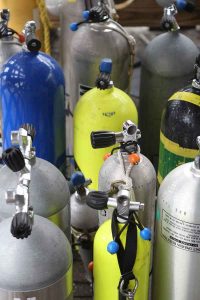So why would anyone care about what’s stamped on a scuba tank? Maybe you’re in the market for a used tank and you want to get a sense of its age and history; maybe you want to make sure that guy at the dive shop isn’t trying to sell you a hydro before you actually need one; or maybe, being a gearhead, you’re just curious.
Standard tanks have standard crown markings. Other tanks, especially those of the steel variety, often will provide additional markings to indicate tare weight, maximum test pressure, carbon dioxide capacity, etc. The following markings were taken off an everyday aluminum 80 pulled from ScubaLab’s tank inventory; these types of markings can be found on virtually any tank.

Breaking the Code:
TC-3ALM-207 – Canadian regulatory authority markings.
TC = Transport Canada (showing the tank meets Canadian specifications).
3ALM = Canada’s specification code for 3-gauge aluminum.
207 = the tank’s service pressure (also referred to as working pressure), expressed in bars.
DOT-3AL-3000 – U.S. regulatory authority markings.
DOT = Department of Transportation (showing the tank meets U.S. specifications).
3AL = U.S. specification code for 3-gauge aluminum.
3000 = the tank’s service pressure (also referred to as working pressure), expressed in psi.
P697426
This particular tank’s unique serial number.
LUXFER 10A05 SO80
LUXFER = the tank’s manufacturer
10 = Month of manufacture
A = Inspection code symbol
05 = Year of manufacture
SO80 = Luxfer’s model/part number for this cylinder, indicating its capacity in cubic feet at normal working pressure (this is a standard 80 cubic foot tank; a SO40 would indicate a 40 cubic foot tank, SO30 a 30 cubic foot tank, and so on).
11 DO/69 12
Date of most recent hydrostatic test.